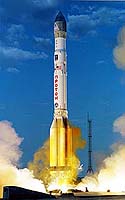| . |  |
. |
Vandenberg AFB - Mar 20, 2003 The last Atlas IIAS rocket scheduled to be launched arrived here March 12. A C-5 Galaxy ferried the historic booster and its Centaur upper stage from Denver, landing at the airfield here around 10:30 a.m. Lt. Col. Clinton Crosier, 2nd Space Launch Squadron commander, said the booster and upper stage would spend a week at a processing facility before being moved to Space Launch Complex-3 for stacking. The Atlas is slated to launch June 16. Crosier said he recognizes the significance of this launch. "The Atlas was one of the first (intercontinental ballistic missiles)," Crosier said. "John Glenn rode an Atlas into orbit in the first (U.S.) manned space program. This launch closes out the Atlas program for Vandenberg." Capt. Ram Riojas, from the 2nd SLS, leads a 400-member team in this historic launch. "The excitement will just grow now that the Atlas is actually here," Riojas said. "We have many people working long hours to prepare this rocket for launch." He added that since the booster's inception at Vandenberg, people have seen about 283 Atlas launches here. There are eight variants of the Atlas booster, and the Atlas V will continue to be used at Cape Canaveral Air Force Station, Fla., Riojas said. In 1988, the Air Force contracted General Dynamics, now Lockheed-Martin, to build the Atlas II booster for the primary mission of launching Defense Satellite Communications System payloads and commercial satellites. This Atlas carries a classified payload to be used by the National Reconnaissance Office for national security. "We are playing a direct role in ensuring the freedoms and liberties of the United States," Crosier said. "I tell people every day not to lose sight of how important this mission is for us because it does have national security implications." The impressive size of this projectile belies its weak outer skin. "The rocket is all stainless steel about the thickness of a dime," Riojas said. "We have to keep it pressurized with an inert gas like nitrogen. Otherwise, it would just collapse on itself." He added that the booster is kept light to maximize the size of payload the Atlas IIAS can carry. Crosier said the final Atlas launch from Vandenberg is truly historic, as the Atlas program has served the Air Force well over the years. "As we fly this last one out, it really is kind of bittersweet," he said. Related Links SpaceDaily Search SpaceDaily Subscribe To SpaceDaily Express
 Ottawa - Mar 20, 2003
Ottawa - Mar 20, 2003International Launch Services (ILS) finalized a contract with Telesat this week to launch the Anik F1R satellite on a Russian Proton rocket in 2005. The deal includes an option for launching an additional satellite. Financial terms were not disclosed. |
|
| The content herein, unless otherwise known to be public domain, are Copyright 1995-2006 - SpaceDaily.AFP and UPI Wire Stories are copyright Agence France-Presse and United Press International. ESA PortalReports are copyright European Space Agency. All NASA sourced material is public domain. Additionalcopyrights may apply in whole or part to other bona fide parties. Advertising does not imply endorsement,agreement or approval of any opinions, statements or information provided by SpaceDaily on any Web page published or hosted by SpaceDaily. Privacy Statement |